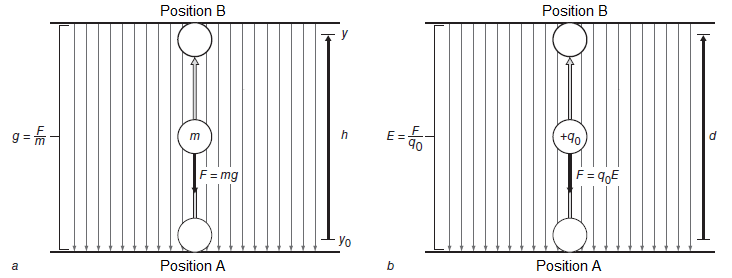Bioelectricity: Core principles
 Electric potential energy
Electric potential energy
Potential Upon addition of similarly charged particles to a conductor, the distance between the particles decreases, which makes it cost more and more energy per unit charge to add additional charge in accordance with Coulomb's law. This is the potential or voltage of thatconductor, expressed in volts (\(\mathbf{V}\)). Actually, we should speak about a potential difference: the potential difference between two points \(A\) and \(B\) in an electric field means the work to be done to move a positive unit charge along any road from \(B\) to \(A\). The electric potential at a point in an electric field can then be understood as the work done to move a positive unit charge from the earth or from the infinite to that point. An electric voltage can be measured with a voltmeter.
Agreement In contrast to the use of the letter \(U\) in secondary schools for voltage, we use the more common international symbol \(V\) according to the SI system.
In fact, \(U\) is the symbol for electrical potential energy and \(V\) the symbol for electrical potential energy per unit charge, i.e. \(U=V\cdot {q_0}\) for a positive unit charge \(q_0\).
Voltage source A battery is used for storage of electricity, and serves as a voltage source, that is, may maintain a voltage difference between the ends, also referred to as poles, for an extended period of time when placed in an electric circuit. In a battery electrons are released by means of a chemical reaction at the negative pole, while on the positive pole at the same time electrons are bonded via another chemical reaction. When the poles of a battery are connected to each other (for example, by a conductive wire), the electrons from the negative pole can oveto the positive pole currents. There is a current; a general convention is that the direction of the current in the circuit is from the positive pole to the negative pole (i.e., opposite to the direction in which the electrons move).
![]() The symbol for a battery in an electric circuit is two nearby continuous lines, in which the longest line segment, labeled \(+\), represents the positive pole and the shortest line segment, labeled \(-\), indicates the negative pole. The \(+\) and \(-\) characters are often omitted because one can clonclude from the size of the line segments in the symbol, which side represents the positive pole, and which side represents the negative pole.
The symbol for a battery in an electric circuit is two nearby continuous lines, in which the longest line segment, labeled \(+\), represents the positive pole and the shortest line segment, labeled \(-\), indicates the negative pole. The \(+\) and \(-\) characters are often omitted because one can clonclude from the size of the line segments in the symbol, which side represents the positive pole, and which side represents the negative pole.
We have orientend the symbol of a battery in the explanation vertically because it helps understand the analogy between electric potential energy and potential energy in a gravitational field. Where work is required to bring a mass from a low to a high position, also work is needed to move a positive charge toward a plus pole. The following picture visualises this: in part (a) work is needed to move a mass \(m\) in a gravitational field of gravity \(g\) with a height increase of \(h\) and this work is equal to \(m\cdot g\cdot h\); in part (b) work is needed to move a positive charge \(q_0\) in a uniform electric field between two oppositely charged plates with mutual distance \(d\) and with field strength \(E\) from the negatively charged plate to the positively charged plate, and this work is equal to \(q_0\cdot E\cdot d\). Charge \(q_0\) and field strength \(E\) in electricity theory correspond to mass \(m\) and gravity \(g\) in gravitational theory, respectively.



